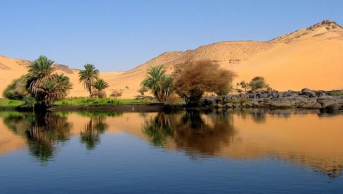A Major Bulwark Against the Impacts of Climate Change in the Middle East: The Ilisu Dam Rising

As the completion of the Ilısu Dam is within close sight, it becomes apparent that it will become one of the mostly debated projects of the present decade. Although ithas long been a hot topic in discussions between Iraq and Turkey concerning the utilization of the transboundary Tigris River’s waters, the main significance of the project still needs to be explored in the area of climate change, and in a wider, regional context.
Iisu Dam is located on the Tigris river. It will create a reservoir with a maximum volume of approximately 11 billion cubic meters and a surface area of 313 square kilometers. The Ilısu power station, consisting of six 200 MW turbines, will thus have a total capacity of 1,200 MW. It is expected to produce 3,800 GWh of power per year.
Ilısu Dam is part of the Southeastern Anatolian Project (GAP) and it is the third biggest hydro dam in the GAP context. Also it is currently the largest hydropower project under construction in Turkey. The taskmaster of the project is the State Hydraulic Works of Turkey, a highly experienced institution in water works in Turkey. As of June, 96% of the project is completed.
For quite some time, Turkey incessantly tried to explain to the outside world that there is an overriding public interest in the project. Also Turkish official arguments centered around the view that the possible negative impacts associated with Ilisu are effectively minimized. Turkey’s arguments can be listed in detail as follows: a) The Ilısu Dam is not designed for irrigation, only for power generation: The water passing through the turbines has to flow back into the riverbed. b) River water flowing into Iraq and Syria will not be polluted because the use of water for hydropower is non-polluting. Ilısu does not involve irrigation. c) As a result of Ilısu, new sewage treatment facilities will be built in the towns upstream, thus improving water quality. d) Ilısu will act as regulator holding back water during the winter floods and releasing it during the summer droughts.e) Claims that 15 towns and 52 villages will be flooded are misleading. f) Hasankeyf, a small town, is the only one affected, with the lower parts of the town being flooded. The citadel will stay above the water. Archaeologists and scholars from Turkey and several other countries are at work on a project to excavate, record, and preserve as much as possible. g) A comprehensive program of settlement and compensation is planned. The total number of people who will have to be resettled is around 15,000. This means about two thousand families. They will be given the choice of whether they prefer an agricultural or an urban settlement. Contrary to allegations by certain NGOs, there are people of different ethnic origins in the region. h) Ilısu will have major environmental benefits. It will avoid the emission of millions of tons of greenhouse gases from alternative thermal power plants.i) A development project means economic growth. In the case of southeastern Turkey, construction and additional electricity will bring higher income levels and new opportunities to an area which badly needs them.
Making use of one country’s natural resources, like water, is a very ordinary, well-established and sometimes an irresistible practice. Examples are ubiquitous. Think of the Ethiopian hopes from the Grand Renaissance Dam on the Blue Nile. Or once Egypt’s expectations from the High Aswan Dam. Not only members of the developing world, but even the mightiest world actors like the USA attributed great significance to completion of great dams for their well-being. The Hoover Dam, which is built in order to ‘make the desert bloom’, on the transboundary Colorado River, is very illustrative. The US did not stop its massive water development project despite lack of an agreement with the downstreamer Mexico. It was almost a decade after the completion of the Hoover Dam, the US and Mexico finally managed to reach a deal. What is more, in the that Treaty (1944) the US promised to release only 1.9 billion cubicmeters of water to Mexico per annum, which is merely a tiny amount of water when compared with the 35 billion cubicmeters of water stored the Lake Mead, behind the Hoover Dam. Therefore, dam building can be, and generally is, accepted as a royal road towards prosperity by many many nations across the globe, regardless of the nature of the river (national or transboundary).
No matter when a nation caught the train of the so-called “hydraulic mission”, dams are always creating a “buoyancy force” for the economy of the country who builds it, and even economic benefits for the region extending beyond the national boundaries. For instance, the electricity to be produced by the Grand Ethiopian Renaissance Dam can provide cheap and sustainable power for Sudanese and Egyptian power-thirst economies. Likewise, the positive agricultural effects of the GAP Project -such as the increasing yields- cannot be thought in isolation. Eventually, all countries of the region will be better off. Ilisu is not an exception. It will contribute 1.3 billion Turkish liras to Turkish economy. But, in a broader perspective, Ilisu will contribute to the general regional economy as well.
Apart from all the discussed dimensions of the Ilisu Dam above, its ameliorating effects on the climate-change-threatened region is worth noting. Climate change related impacts have become highly visible in Mesopotamia. Unprecedented extreme events, such as intense heat waves, extended periods of no-precipitation, early melting of the snowpack in Taurus mountains, are being recorded. Almost all climate change impacts will negatively influence the water availability in the region. In these circumstances, with around 11 billion tonnes of water, the Ilisu will act as a guarantee for periods of prolonged drought. Its location in a less evaporation-prone part of the basin makes it a perfect storage for dry times. Its topography and geographical position is better than all Iraqi dams downstream which are heavily affected by evaporative losses. To conclude, in discussions around Ilisu, its climate-related benefits should not be ignored.









